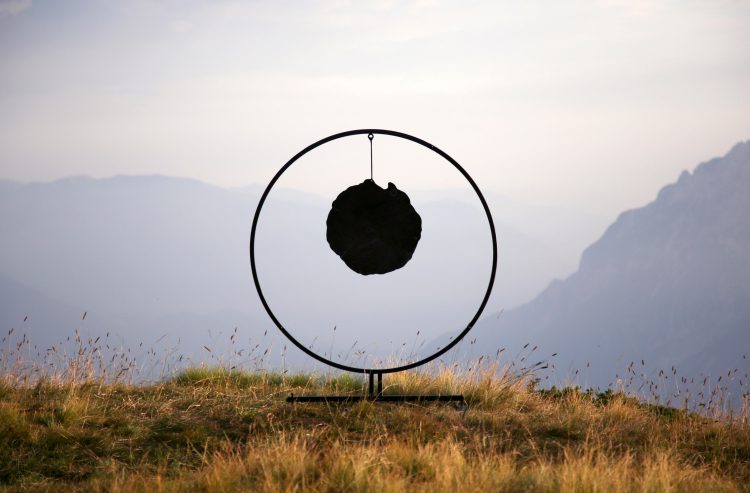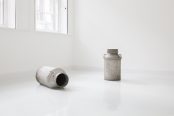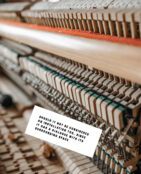Runes, stone, iron, the Alps, ancient forges and printing presses … the symbolisms and materials of Neunau’s sonic art are as distant from the mainstream as its mountainous base in Valcamonica is from the centres of metropolitan centres of cultural activity that tend to host sound and contemporary art.
Neunau’s mastermind Sergio Maggioni is organically rooted in place and history, but this certainly doesn’t imply an anti-technological traditionalist approach. As he observes:
“Neunau is a connection between worlds that might seem distant from one another, this allows me to work on various levels. My aim is not only to record sounds that could be useful in music writing in the more classical sense, but also tell a story of the location where they have been recorded, giving the listener a physical perception of sorts, something more akin to an experience.”
This approach allows significant sites and their material and cultural histories to speak via Neunau’s amplification of them and their resident sounds. The resulting performances, installations, videos and recordings are the final result of what Maggioni terms “sound investigations”, based on “an archaeological and musicological approach”. Sounds are often captured and manipulated in situ, documenting and animating spaces and their histories.
Fittingly, the first Neunau release, Sounds from the Forge was inspired and derived from an ancient, water-powered iron forge that still operates. The video reveals how the forge was turned into a recording studio, capturing the local craft tradition, of which Neunau is simply the most recent expression. Maggioni discusses how the advent of the Iron Age and introduced the new sonorities of metalwork to the Alpine valleys.
“From early on in our history the Camuni tribes worked rocks with primordial metal tools, a visceral gesture giving the idea of a ritual dance for the cosmos, creating images to testify and express their necessity to communicate something that would last for thousands of years to come.”
Here some may suspect a conservative agenda, but the way in which Neunau moves between using archaic and hyper-contemporary materials, suggests that it is neither traditionalist nor Futurist. It is pragmatic and intuitive, rather than rigidly ideological.
“… what I perceive when entering a space is fundamental for the visual and sonic narrative that I intend to pass on to the listener.”
Neunau is also a performance project, taking over and amplifying spaces such as the former thermo-electric power station Daste e Spalenga in Bergamo (2016). Other spaces used have included a de-consecrated church in Milan, the site of Quadraphonic Transmission – Live in S.Vittore and the Forty Martyrs, which was inspired by the singing of the Cistercian monks of the Chiaravalle abbey.
The most recent album, Rimodulazione di flauti Paetzold durante una sessione di libera improvvisazione di Antonino Politano is a reworked recording of an improvisation recorded in a Val Camonica church. Here again, the location is significant: the church contains the oldest frescoes depicting the use of Alpine herding horns and in its new role as recording studio, acted almost as a collaborator with the flautist, who wore a contact microphone on his trachea while performing. This signal was blended with the signals of other contact and room microphones, in what Maggioni intriguingly describes as “a process very much reminiscent of carpet weaving process, starting from the untreated sound matrix and expanding it into numerous directions.” The sheer range of resulting sounds is fascinating, ranging from gamelan-like tones to unearthly drones and seemingly impossible sonic textures. In a further nod to local tradition, the cover art is based on an early carpet weaving tradition known as “pezzotto”. Neunau is at home in sacred locations, both pagan and christian and reanimates them both with their own sounds and with ancient and modern technologies.
Maggioni argues that “confronting yourself with antique masters of the craft allows you to give the right value and appreciation to the tools we have and use nowadays.” For the album Il Ciclo del Vuoto (The Void Cycle) he collaborated with another regional craft, collaborating with Artogne’s Lodovico Pavoni Printing Museum and its collection ranging from the 1700s to the 1980s. He notes that all the museum’s pre-electronic machines remain fully functional and are still in use, whereas “… some of the more technologically advanced machines have become obsolete. This to me means that not everything that is defined as progress is necessarily an improvement.” In this case, an 1880 press was used to hand print the album’s covers, each of which is individually varied. Even this venerable production process, seen in the accompanying video, works as a meditative combination of sound and vision.
The album’s sounds were derived from a commissioned video documentary “Sound of Concrete” and its soundtrack. The field recordings were later forged into the full thematic album based on concrete and a subsequent site-specific live performance. The film explored the lifecycle of cement, from explosions in the quarry of Tavernola, to the cavernous concrete work spaces of the Pantano dam. In the video Maggioni can be seen carefully testing metal and concrete surfaces and taking field recordings of concrete production processes.
“Neunau is a connection between worlds that might seem distant from one another, this allows me to work on various levels. My aim is not only to record sounds that could be useful in music writing in the more classical sense but also tell a story of the location where they have been recorded, giving the listener a physical perception of sorts, something more akin to an experience.”
An even older location featured in Shelter under a rock before Vaiai storm (2018). This used ancient recall horns used for herding animals and took advantage of the a sheltered space under a boulder in the midst of a forest. The title and a key value of the work come from the fact that in the following autumn all the trees in the area were felled in the Vaiai storm, leaving this work as a document of an acoustic conceptual document of a brutally altered landscape. It was also inspired by the ancient instruments used:
“… the sound of the Ibex Horn is precious and playing it is a strong and precise signal that goes straight into our limbic system, to the archaic part of the human brain. The area that governs all the spontaneous and automatics reactions, taking us straight back to the origin of our species.”
Within the context of the Neunau worldview, there is no contradiction in moving seamlessly from working with ibex horns to the most advanced industrial machinery. The project Il Suono Nascosto (The Hidden Sound) is emblematic of Maggioni’s approach to excavate and amplify normally hidden sounds. It resulted in a performance in the factory of the Biesse Group, using sounds and visuals from their production processes. Just as with his engagement with forges or printing presses, the evolving relationship between people and technology is explored here.
The mobile, interactive installation project Màder (2020) appeared in six atmospheric locations in Maggioni’s home region. Throughout July and August specially forged iron discs and gongs were hung for audiences to experiment with. The installation was accompanied by signs bearing the slogan “Osserva percuoti suono!” (Observe Strike Sound!). This conscious use of primitive techniques and materials seems to invite both experimentation and contemplation, appealing to a wide range of local people, far beyond the normal reach of sound art and other contemporary forms. Regardless of whether Neunau manifests through ancient or hyper-modern forms and techniques, neither concept nor technology ever prevail over sonic imagination and a relation to local history and spirit.
MADER Photo by PAOLO RONDINI
The album Rimodulazione di flauti Paetzold durante una sessione di libera improvvisazione di Antonino Politano is available now.

From Speak and Spell to Laibach.





















